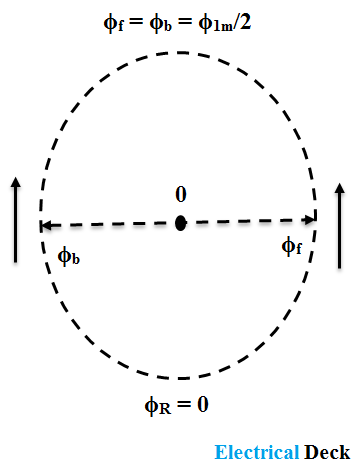When a single-phase ac supply is given to the single-phase stator winding, a sinusoidally pulsating magnetic field varying with time is produced. As the produced magnetic very two times in a cycle, therefore, no torque will be produced in the rotor and hence the rotor doesn't rotate. Therefore, single-phase induction motors are not self-starting motors.
However, when an initial rotation is given to the rotor, it starts rotating in that direction which can be explained by the double-revolving field theory.
The magnetic field produced by the stator winding when an alternating supply is given is equal to the sum of the two revolving fields rotating at synchronous speed in the opposite direction of equal magnitude. The magnitude of each revolving field is equal to one-half of the maximum value of the alternating field, i.e., Φ1m/2, where Φ1m is the maximum value of an alternating field.
Let us consider the two revolving fields as Φf (rotating in an anti-clockwise direction) and Φb (rotating in a clockwise direction). The resultant ΦR of these two fields gives the value of the magnetic field produced by the alternating supply (i.e., alternating field).
Consider the Different Instances as Shown Below :
The two fields Φf and Φb are shown opposite to each other at the start, and the resultant magnetic field ΦR = 0. After 90°, the two fields are rotated in such a way that both of them are now pointing in the same direction. The resultant magnetic field,
This instant gives maximum the magnitude of the original alternating field. So the continuous rotation of these two fields (components) gives the original stator magnetic field. This is purely alternating in nature.
Now each separate component is rotated and hence gets cut by the rotor conductors. Due to cutting of flux emf gets induced in rotor conductors which circulate in the rotor current. The rotor current produces rotor flux.
The rotor flux interacts with one component Φf produces a torque in an anti-clockwise direction and the rotor flux interacts with the second component Φb produces a torque in a clockwise direction.
If anticlockwise torque is assumed positive, then the clockwise torque produced by another is negative. The resultant of the two torques at the start is zero. Torque-speed characteristics are shown below.



